If you want to build a bigger and stronger chest, you should add inner chest exercises to your chest workout routine.
Why is an inner chest workout so vital? They are smaller than the upper and lower chest muscles, but they are still important for strength and a defined look.
The greatest technique for strengthening your inner chest is to do exercises that encourage you to move your arms toward your chest’s midline.
Training the complete chest muscles gives you a balanced and proportionate chest.
In this blog, we’ll blog we will discuss the following topics:
- What are Inner Chest Muscles
- How To Train Them
- 10 Best Inner Chest Exercises
- Common Mistakes To Be Avoided
- Tips and Techniques
- Training Volume
- Workout Plan
- FAQs

- What are the Inner Chest Muscles?
- How To Train Inner Chest
- 10 Best Inner Chest Exercises To Build Mass and Strength
- 1. Narrow Grip Push-Ups
- 2. Dumbbell Squeeze Press
- 3. Dumbbell fly
- 4. Dumbbell Pullover
- 5. Landmine Chest Press
- 6. Smith Machine Hex Press
- 7. Pec Deck Fly
- 8. Cable Crossover
- 9. Single Arm Chest Fly
- 10. Plate Squeeze Press
- Common Mistakes To Avoid When Training the Inner Chest
- 1. Focusing solely on isolation exercises
- 2. Neglecting proper form
- 3. Ignoring progressive overload
- 4. Not giving your muscles enough time to recover
- 5. Overemphasizing the squeeze
- 6. Forgetting about nutrition
- Tip and Technique To Build Inner Chest
- 1. Optimize Training Volume
- 2. Progressive Overload
- 3. Grip and Hand Position
- 4. Incorporate Compound Exercises
- 5. Add Variations
- 6. Focus on mind-muscle connection
- 7. Inner Chest Beginner Workout Plan
- 8. Advance Middle Chest Workout Routine
- People Also Asked
- How do I build my inner chest line?
- How do you work your inner chest?
- Would it be possible to isolate the inner chest muscles during a workout?
- How often should I train my inner chest?
- Can I target the inner chest without using weights or machines?
- Best Inner Chest Bodyweight Exercises At Home
- What are The Benefits Of Dumbbell Inner Chest Workout
- Why is doing an inner chest workout with a cable beneficial?
- Takeaway
- References
What are the Inner Chest Muscles?
To effectively target the inner chest, it’s essential to have a basic understanding of the underlying anatomy. The chest muscles, or pectoral muscles, are divided into two main parts:
The pectoralis major comprises the upper head (or clavicular) and the lower head (or sternal).
The inner chest is the region of the chest that is located between the two pectoralis major muscles. It’s the most prominent muscle of the pecs. The sternal head, which is the lower chest, is the home of the inner chest.
So, to hit the center part of your pecs, you need to perform exercises where the arms come together (or even cross) the body’s midline.
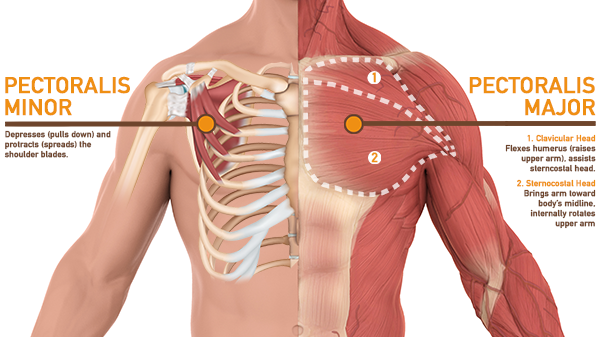
How To Train Inner Chest
The number of reps and sets for an effective inner chest workout will vary based on your fitness level, weekly workout frequency, and strength training goals.
- For strength gains, do 4 to 6 sets of 1 to 6 reps each exercise with a weight of at least 85% of your one-repetition maximum (1RM). The fewer reps you perform, the closer to 100% of your 1RM you should strive for.
- If your goal is hypertrophy (muscle growth), perform three sets of each exercise, using loads that are 70 to 85% of your 1RM for 8 to 12 reps.
- When training for endurance, it is usually recommended to use higher reps (15 to 20 repetitions) and moderate loads with a weight of at least 50 to 70% of your 1RM.
Your Free Calculator To Know Your BODY MASS INDEX
10 Best Inner Chest Exercises To Build Mass and Strength
Now, let’s explore the best inner chest exercises for strengthening your chest and improving posture using various types of fitness equipment and some bodyweight workouts that you can do at home.
Here is a list of 10 best exercises to strengthen the center chest and help you achieve a strong, defined chest.
- Dumbbell Inner Chest Exercises
- Dumbbell Squeeze Press
- Dumbbell fly
- Dumbbell Pullover
- Landmine Chest Press
- Smith Machine Hex Press
- Pec Deck Fly
- Cable Crossover
- Single Arm Chest Fly
- Plate Squeeze Press
1. Narrow Grip Push-Ups
Narrow grip push-ups are the best bodyweight workout for building your entire upper body, including shoulders, chest, and triceps. It’s one of the best inner chest exercises you can do at home.
This is evidenced by a study that found greater electromyography (EMG) activity in the triceps brachii and inner chest when doing close push-ups compared to when executing regular push-ups.
Close grip push-ups can be challenging, so starting with a modified version (knee push-ups) is important if needed.

How To Do
- Begin in a plank position with your hands directly under your shoulders and your feet hip-width apart.
- Move your hands closer together so that they are directly under your chest, with your fingers pointing forward.
- Lower your body towards the ground, keeping your elbows close to your sides.
- Pause at the bottom of the movement and then push back up to the starting position.
- Repeat for the desired number of reps.
Tips
- Exhale while you exert.
- Keep flexing the inner pecs as you lower down, and then return
Read More: Best Push-Ups For Inner Chest To Build Size And Strength
2. Dumbbell Squeeze Press
If you’re looking for a straightforward inner chest dumbbell exercise to add to your routine, a dumbbell squeeze press is a great staple workout to get you started.
During the squeeze press, the dumbbells are always in contact with each other, and you’re actively squeezing them inward (against each other) as hard as possible.
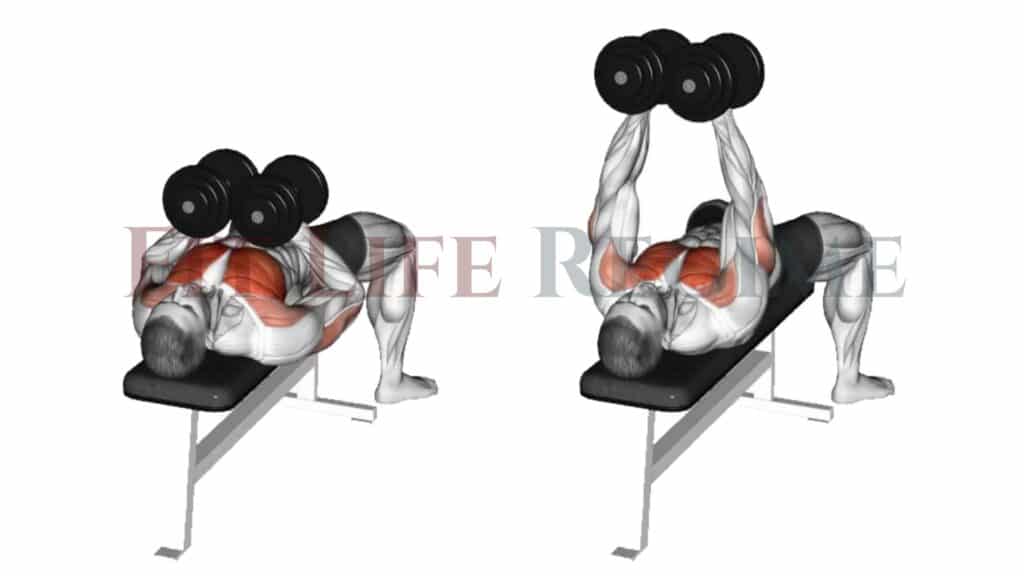
How To Do
- Take the dumbbells in each of your hands and lie down on the bench.
- Place the dumbbells together side by side and lift them up over your chest.
- You’ll want to maintain a lot of tension in the chest.
- Lower them down together, touch the chest, and then push the dumbbells back up.
- Repeat for the desired number of repetitions.
Tips
- Breathe out on the way up.
- Maintain more tension through the pecs by not locking out the elbows entirely.
3. Dumbbell fly
The dumbbell fly utilizes a chest fly movement pattern to isolate the chest muscles, helping the muscles to grow better and become stronger.
The dumbbell fly takes advantage of arm rotation to really target all areas of the pecs, but most significantly, the inner chest.
It is often thought of as a classic bodybuilding movement, as the goal of the exercise is to isolate the chest for aesthetic purposes.
Try other variations of chest fly to train inner pec muscles:
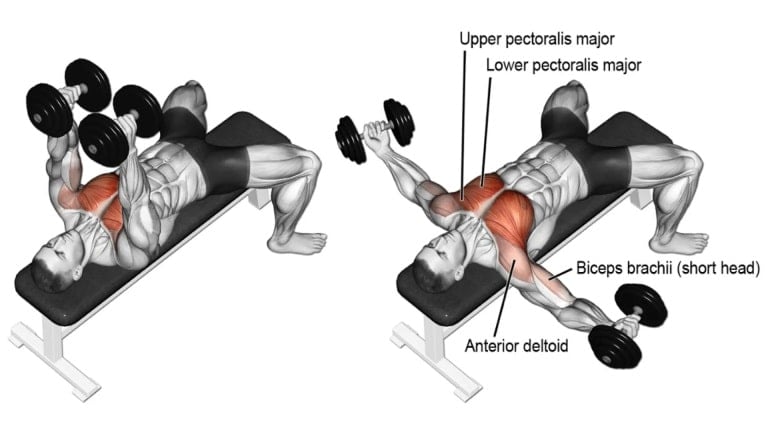
How To Do
- Lie on the flat bench with your feet flat on the floor.
- Lift your arms straight up from your shoulders and the dumbbells directly over your upper chest.
- Slowly lower your arms to your sides until your wrists reach about shoulder level or slightly above.
- Bring your arms back toward the center of your body and use your pec muscles to draw them back together.
Tips
- Perform press in a controlled manner.
- During every single rep, keep the tension on the chest.
4. Dumbbell Pullover
The classic dumbbell pullover is a widely used resistance exercise that primarily strengthens the muscles in the chest and back.
It also engages the large wing-shaped muscles in the back (latissimus dorsi), the core muscles, and the triceps.
It involves lying down on a bench and moving a dumbbell over your head while maintaining a slight bend in your elbows. They are an excellent addition to your upper body strength routine.
There are variations of pull-over that help to grow the inner chest.
- Barbell pullover
- Cable Pullover
- Incline pullover
- Decline pullover
- Swiss ball dumbbell pullover

How To Do
- Lie across on a bench on your shoulders so that your head is hanging.
- Grasp a dumbbell with both hands and get it straight over your chest.
- Lower the dumbbell in an arc slowly, getting a good stretch in your rib cage.
- Lower the dumbbell as far as possible and then raise it back to the starting position.
- Repeat for your desired number of reps.
Tips
- Maximum stretching ensures the greatest expansion of the rib cage.
- Use a weight that challenges you but allows you to maintain proper form.
- Relax your hips and let them fall, as relaxed hips help in extra expansion.
- Keep your core tight and your lower back flat against the bench.
5. Landmine Chest Press
If you’re looking for a way to get more creative with your inner chest workout, why not try the landmine chest press?
The landmine press is not a popular exercise, yet it provides many benefits, like progressing overload.
It can be performed in a kneeling position, which increases core involvement and can improve the core stability and strength of the abdominal muscles. It’s one of my favorite exercises to train the inner pec muscles.
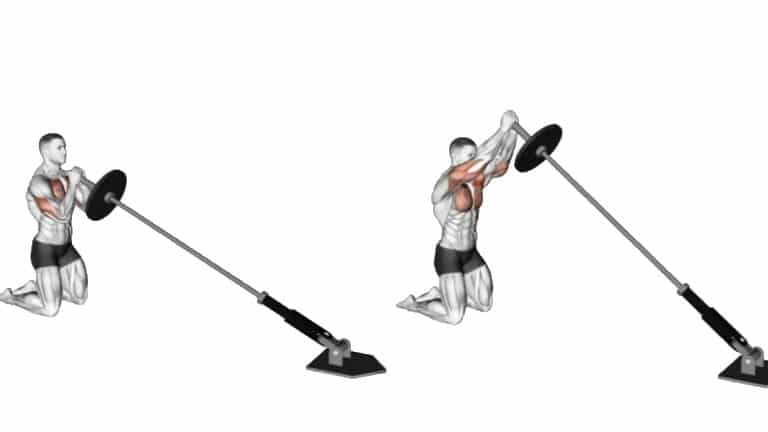
How To Do
- Place a barbell in a landmine holder or set up a barbell in a corner.
- Then, add weight plates to the free end of the barbell.
- Assume a half kneeling position with the knee under your hip, toes tucked, and rib cage down.
- Press the barbell up straight in front of you until your arms are extended, avoiding hyperextension at the elbows.
- Hold the weight for a second and focus on contracting your chest muscles.
- Slowly lower the weight back towards your chest, and then repeat.
Tips
- To secure the barbell, you can interlock your hands around the bar.
- Lean your body forward slightly and engage your core muscles to help with stabilization.
- Exhale on pushing movement, and inhale when returning to the starting position.
- Contract the chest muscle at the top of the movement.
6. Smith Machine Hex Press
The Smith machine hex press allows for a greater range of motion and more emphasis on the inner chest muscles than a traditional bench press. It gives effective engagement and excellent weight distribution.
However, it is challenging to organize and requires much attention and detail to perform this workout.
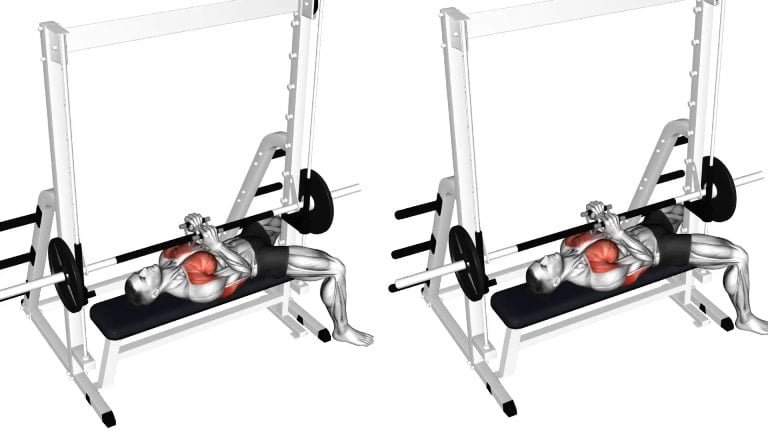
How To Do
- Set up a Smith machine with the bar at waist height.
- Lie on a bench with your feet flat on the ground, and position yourself underneath the bar.
- Grip the bar with the V-Bar handle and slowly lift it off the rack.
- Press them straight out in front of your chest.
- Lower the weights under control. Then, repeat 10-12 reps.
Tips
- Focus on powerful contractions and slow eccentric.
- Perform press in a controlled manner.
- Focus on mind-muscle connection
7. Pec Deck Fly
The pec deck fly is an isolation exercise primarily targeting the chest muscles, including the inner chest. It is a popular exercise in gyms and fitness centers because it isolates the chest muscles.
This means that the exercise only works the chest muscles without actively working the triceps or shoulders.
This exercise provides a smooth and controlled movement, resulting in a more focused and intense workout. It is used in strength training and bodybuilding routines to build bigger and stronger chests.
My main focus when doing this exercise is creating a mind-muscle connection to maximize the output.
EMG data shows that machine fly and bench press both activate the pectoralis major muscle similarly.
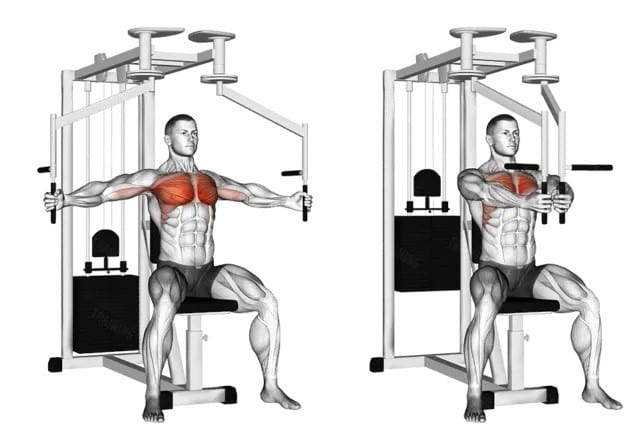
How To Do
- Adjust the seat so that your feet are flat on the floor.
- Ensure that the handles are at chest level or slightly below.
- Grab the vertical handles with elbows slightly bent.
- Keep your chest lifted, shoulders down and back, and core engaged.
- Exhale as you slowly bring the handles together in front of your chest.
- Once the handles are together, pause briefly at the fully contracted position. Squeeze your chest muscles and feel the tension in the target area.
- Inhale and gradually release the handles, allowing your arms to return to the initial position.
Tips
- Your upper arms should be parallel to the floor.
- Keep your eyes straight ahead while performing the exercise.
8. Cable Crossover
The Cable Crossover is a resistance training exercise primarily targeting the inner chest muscles. The exercise involves using cable machines to perform a fly-like motion with the arms, crossing them in front of the body.
The cable provides constant resistance, helps develop central chest muscles, and provides much-needed stress on the middle pecs.
Other Variations Of Cable Crossover
- High Cable Crossover: Set the cables to a high position to target the lower chest muscles
- Low Cable Crossover: Set the cables low to target the upper chest muscles.
- Single-Arm Cable Crossover: Perform the exercise one arm at a time to increase stability and engage the core muscles.
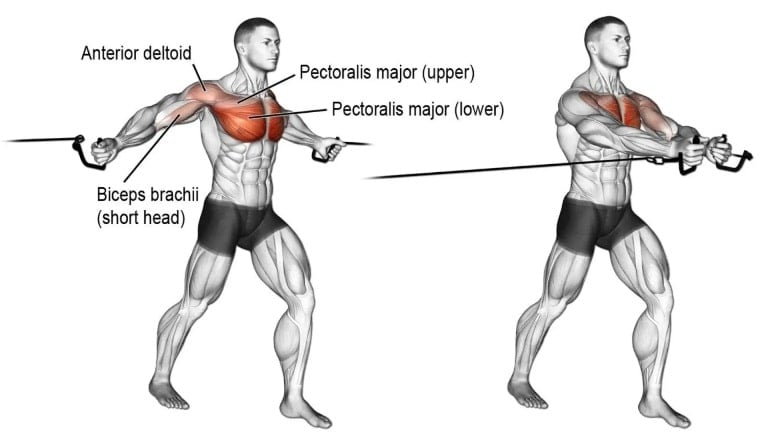
How To Do
- Start by setting the cable machines to the desired height and weight.
- Stand between the two cable machines and grasp the handles.
- Step forward with one foot and lean slightly forward at the hips.
- Keeping the arms straight but not locked, bring the handles together in front of the body, crossing them at the wrists.
- Slowly lower the arms back to the starting position, maintaining control and tension in the chest muscles.
- Repeat.
Tips
- Keep the core engaged and the back straight.
- Avoid arching the back or rounding the shoulders.
- Use a weight that allows for proper form and controlled movements.
Know More: 14 Best Cable Chest Exercises
9. Single Arm Chest Fly
You can add plenty of single-arm chest exercises to correct potential imbalances when doing an inner chest workout with a cable machine.
During exercise, emphasis is placed on bringing the resistance further across the body and past the midline, thus extending the range of motion to force an intense peak contraction in the middle pec.
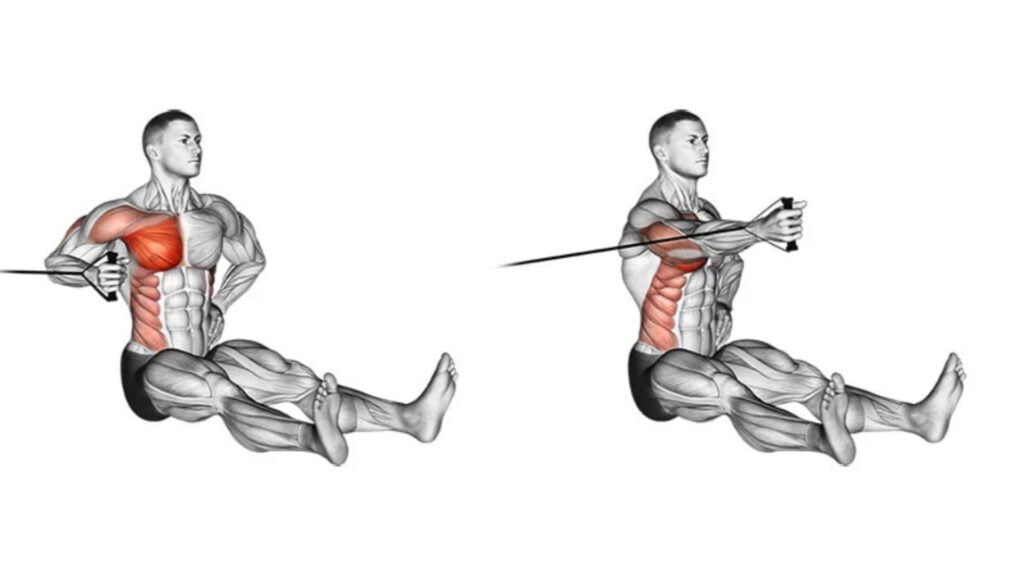
How To Do
- Begin by moving the pulleys to the high position, selecting the resistance to be used, and taking a handle in one hand.
- Extend your arm and make sure to have a slight bend in your elbow.
- Pull your hand to the center line of your chest while keeping your upper body straight.
- Hold for a second, and return to the starting position to complete one rep.
Tips
- Always keep the elbows slightly bent for full inner pec activation.
- Keep a controlled motion and avoid jerky movements.
Read More: Cable Fly: Muscle Worked, Alternate, Variations
10. Plate Squeeze Press
The plate squeeze press is a great option for adding to your chest workout regimen to increase muscle hypertrophy and create chiseled and defined pectorals.
It is an alternative and free-weight exercise that primarily targets the inner and upper chest and, to a lesser degree, also targets the shoulders and the triceps.
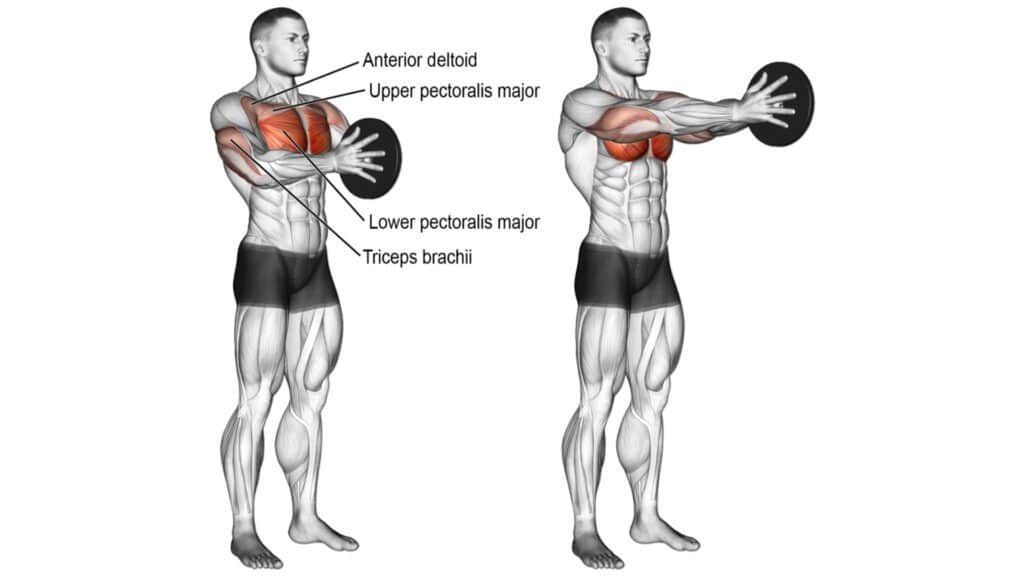
How To Do
- Grab 2–3 plates and squeeze them together with your palms.
- Bring the plates to the center line of your chest and extend your arms forward and slightly upward.
- Contract your chest as hard as possible. Maintain tension on the inner and upper chest.
- Reverse your arms in the exact same movement pattern.
Tips
- Use a controlled tempo to push your arms up and forward.
- Remember to breathe properly.
Common Mistakes To Avoid When Training the Inner Chest
Training the inner chest can be challenging, and avoiding certain common mistakes is essential to get the best results.
1. Focusing solely on isolation exercises
Isolation exercises like cable crossovers and pec deck flies are useful for targeting the middle chest.
It’s essential to incorporate compound exercises like bench presses and push-ups to stimulate overall chest growth.
2. Neglecting proper form
Performing exercises with the correct form is crucial to target the inner chest effectively.
Failing to do so can put undue stress on other muscle groups and limit the effectiveness of the exercise.
3. Ignoring progressive overload
To continue making gains, it’s essential to gradually increase the weight or reps you’re using to challenge your chest muscles. Failing to do so can lead to a plateau in progress.
4. Not giving your muscles enough time to recover
Overtraining your inner chest can lead to fatigue, soreness, and even injury. Giving your muscles enough time to rest and recover between workouts is important to avoid overtraining and maximize your gains.
5. Overemphasizing the squeeze
It is important to emphasize the contraction and squeeze of the middle chest, but excessive emphasis can lead to a decreased range of motion and limit the overall effectiveness of the exercise.
6. Forgetting about nutrition
Proper nutrition, including adequate protein intake, is crucial for muscle growth.
Neglecting this aspect of your training can limit your results, no matter how hard you work in the gym.
Tip and Technique To Build Inner Chest
The inner chest can be a stubborn area to build since it has bigger and stronger fibers that require much more work to grow.
A well-developed middle pec makes the chest look bigger and more complete, showing that you are a serious lifter who has worked hard at the gym.
There are ways to target the inner pec fibers, but separating one part of a muscle is impossible.
1. Optimize Training Volume
To train the inner chest effectively, it’s important to focus on both training volume and technique. Here’s what you need to know:
Training volume refers to the total amount of work you perform during a workout, including the number of sets, reps, and weights used.
Sets
According to the latest scientific evidence, 12–20 weekly sets per muscle group may optimize muscle growth.
- Beginners: ~10 sets per week.
- Intermediate: ~15 sets per week.
- Advanced: ~20 sets per week.
When a certain amount of volume stops being effective and your progress stalls, you can add sets to increase volume and use that as a driver of renewed progress.
Reps
The best rep ranges and loads to work with.
- For muscle endurance: Aim for 15-20+ reps with moderate resistance.
- For muscle strength: 6-10 reps, with more resistance.
- For muscle hypertrophy (increased muscle size): Aim for 3-4 sets of 8-12 reps, with a moderate to heavy amount of resistance.
It is always best to start with fewer reps and sets and then gradually increase as your strength improves.
Adding different rep ranges into your workouts can help you target different muscle fibers and promote muscle growth.
Try doing both low-rep sets (4-8 reps) and high-rep sets (15-20 reps) in your chest workouts.
2. Progressive Overload
This is the principle of increasing resistance across sets and workouts. You can increase the weight from set to set but keep it minimal to maintain the rep range.
To be effective, the load should bring you to or near failure within the given rep ranges.
You’ll find a way to incorporate most of, if not all, into your chest routine. Variety promotes gains in strength and size and helps to prevent plateaus. The chest responds well to variety.
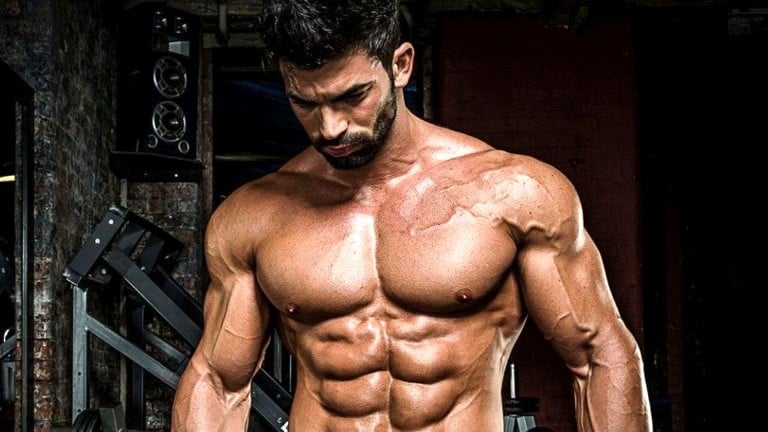
3. Grip and Hand Position
The middle chest muscles work hard when you place the hand closer than the shoulder width and squeeze the chest near the top.
Keeping your arms slightly wider than shoulder width is perfect for overall chest development.
4. Incorporate Compound Exercises
Compound exercises like bench presses and push-ups should form the foundation of your chest workout, as they engage multiple muscle groups.
Start with heavy compound exercises and finish with isolation exercises.
5. Add Variations
To train the chest from different angles, try using different types of equipment, such as a dumbbell, barbell, or plates, for performing exercises.
Examples of such exercises include dumbbell flyes, dumbbell pullovers, cable crossovers, close-grip bench presses, and push-ups with hands close together.
6. Focus on mind-muscle connection
Mind-muscle connection refers to the ability to mentally focus on the muscles you’re working on during an exercise.
This technique can help you isolate and activate your chest muscles more effectively.
Focus on feeling the contraction in your inner chest muscles during each repetition.
7. Inner Chest Beginner Workout Plan
The following inner-chest workout is highly effective and would show results if done with proper technique and sequence.
You can do a beginner chest workout at home if you have dumbbells. Otherwise, you can perform these exercises at the gym.
| Exercise | Sets | Reps |
|---|---|---|
| Close Grip Push-Ups | 4 | 10-15 |
| Dumbbell Squeeze Press | 3-4 | 10-12 |
| Dumbbell Fly | 4 | 10-12 |
8. Advance Middle Chest Workout Routine
This advanced middle pec workout makes it slightly more challenging for a beginner.
| Exercise | Sets | Reps |
|---|---|---|
| Smith Machine Hex Press | 4 | 8-10 |
| Cable Crossover | 3-4 | 10-12 |
| Plate Squeeze Press | 4 | 10-12 |
| The Landmine Chest Press: | 3 | 8-10 |
People Also Asked
How do I build my inner chest line?
There is no true way to fully isolate only the inner chest without also working the rest.
However, with that said, middle chest-specific exercises still put more tension on that center portion of your chest where your pecs attach to the sternum.
How do you work your inner chest?
The way the muscle is linked to the rib cage makes it tough to target the inner chest specifically, but some workouts hit the entire chest while focusing on the middle pectoral.
Would it be possible to isolate the inner chest muscles during a workout?
It is not possible to isolate the inner chest muscles completely, but you can place a greater emphasis on them by incorporating exercises that target this area specifically, such as the inclined dumbbell fly or narrow grip push-ups.
The chest muscles work together as a unit, and a good chest workout should include exercises that work all parts of the chest.
How often should I train my inner chest?
Train your inner chest at least once a week. If your chest muscles are weak, you should train them 2–3 times weekly.
However, it is important to listen to your body and avoid overtraining, which could hinder progress.
Can I target the inner chest without using weights or machines?
The chest muscles, including the inner chest, can be effectively targeted with bodyweight exercises such as close-grip push-ups and dips.
Best Inner Chest Bodyweight Exercises At Home
Narrow Grip Push-Ups and effectively train your inner pec muscle by using these bodyweight chest exercises at home.
There are many other benefits of training at home, such as No gym members required, more flexibility as you can train as per your schedule, and Required limited space.
What are The Benefits Of Dumbbell Inner Chest Workout
There are many advantages of doing chest dumbbell exercises, such as:
- Dumbbells require more balance than barbells or machines, which can lead to greater muscle fiber recruitment.
- It allows unilateral training and improves muscular imbalances.
- Dumbbell affords a greater variety, preventing physical and mental burnout.
- It allows for a greater range of movement (ROM).
Why is doing an inner chest workout with a cable beneficial?
The cable workout offers an effective way to train the inner chest muscles. Let’s have a look at some other benefits:
- Cable workouts are a great alternative for people who experience discomfort in their joints during the bench press.
- Cable exercises are more evenly distributed, and you have more of a constant load on your chest muscles throughout the whole range of motion.
- It offers unmatched versatility because you can easily change the load, angle, grip positioning, and body positioning.
- The cable setup gives your muscles almost uninterrupted time under tension and a massive pump.
Takeaway
This best Inner chest Exercise and Workout plan is highly recommended for anyone interested in building body strength and gaining muscle.
It is easy to do and requires no more scientific details. If done consistently, the results will speak for themselves.
Thanks for reading; enjoy a workout
References
- Hrysomallis C. Effectiveness of strengthening and stretching exercises for the postural correction of abducted scapulae: a review. The Journal of Strength and Conditioning Research. 2010;24(2):567-574.
- Schoenfeld, B. J., Ogborn, D., & Krieger, J. W. (2017). Dose-response relationship between weekly resistance training volume and increases in muscle mass: A systematic review and meta-analysis. Journal of sports sciences, 35(11), 1073–1082.
- The Effect of Weekly Set Volume on Strength Gain: A Meta-Analysis.
- Comparative Study Eur J Sport Sci. 2016;16(3):309-16. Epub 2015 Mar 23. Influence of bench angle on upper extremity muscular activation during bench press exercise.

Manish brings over 10 years of hands-on experience in weight lifting and fat loss to fitness coaching. He specializes in gym-based training and has a lot of knowledge about exercise, lifting technique, biomechanics, and more.
Through “Fit Life Regime,” he generously shares the insights he’s gained over a decade in the field. His goal is to equip others with the knowledge to start their own fitness journey.
